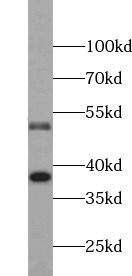Products
CASP8 antibody
| Synonyms: | Caspase-8 (CASP-8)|Apoptotic cysteine protease|Apoptotic protease Mch-5|CAP4|FADD-homologous ICE/ced-3-like protease|FADD-like ICE (FLICE)|ICE-like apoptotic protease 5|MORT1-associated ced-3 homolog (MACH)|Caspase-8 subunit p18|Caspase-8 subunit p10|CASP8|MCH5 antibody | ||
| Catalogue No.: | FNab01293 | Reactivity: | Human, Mouse, Rat |
| Host: | Rabbit | Tested Application: | ELISA, WB, IHC, IP, IF |
| Clonality: | polyclonal | Isotype: | IgG |
| Size | Price |
|---|---|
| 100µg | Inquiry |
- SPECIFICATIONS
- FIGURES
- CONDITIONS
- FAQS
- Product Name
- CASP8 antibody
- Catalogue No.
- FNab01293
- Size
- 100μg
- Form
- liquid
- Purification
- Immunogen affinity purified
- Purity
- ≥95% as determined by SDS-PAGE
- Clonality
- polyclonal
- Isotype
- IgG
- Storage
- PBS with 0.02% sodium azide and 50% glycerol pH 7.3, -20℃ for 12 months(Avoid repeated freeze / thaw cycles.)
- Immunogen
- caspase 8, apoptosis-related cysteine peptidase
- Alternative Names
- Caspase-8 (CASP-8)|Apoptotic cysteine protease|Apoptotic protease Mch-5|CAP4|FADD-homologous ICE/ced-3-like protease|FADD-like ICE (FLICE)|ICE-like apoptotic protease 5|MORT1-associated ced-3 homolog (MACH)|Caspase-8 subunit p18|Caspase-8 subunit p10|CASP8|MCH5 antibody
- UniProt ID
- Q14790
- Observed MW
- 50-55 kDa, 25-32 kDa
- Tested Applications
- ELISA, WB, IHC, IP, IF
- Recommended dilution
- WB: 1:200-1:2000; IP: 1:200-1:2000; IHC: 1:50-1:100; IF: 1:10-1:100
 HepG2 cells were subjected to SDS PAGE followed by western blot with FNab01293(CASP8 antibody) at dilution of 1:1000
HepG2 cells were subjected to SDS PAGE followed by western blot with FNab01293(CASP8 antibody) at dilution of 1:1000
 IP Result of anti-CASP8 (IP:FNab01293, 3ug; Detection:FNab01293 1:500) with HeLa cells lysate 2500ug.
IP Result of anti-CASP8 (IP:FNab01293, 3ug; Detection:FNab01293 1:500) with HeLa cells lysate 2500ug.
 Immunohistochemistry of paraffin-embedded human lymphoma using FNab01293(CASP8 antibody) at dilution of 1:50
Immunohistochemistry of paraffin-embedded human lymphoma using FNab01293(CASP8 antibody) at dilution of 1:50
 Immunofluorescent analysis of ( -20℃ Ethanol ) fixed HepG2 cells using FNab01293 (Caspase 8 Antibody)at dilution of 1:25 and Rhodamine-Goat anti-Rabbit IgG
Immunofluorescent analysis of ( -20℃ Ethanol ) fixed HepG2 cells using FNab01293 (Caspase 8 Antibody)at dilution of 1:25 and Rhodamine-Goat anti-Rabbit IgG
- Background
- Caspase 8, also named as MCH5, MACH, FLICE, and CAP4, belongs to the peptidase C14A family. It may participate in the GZMB apoptotic pathways and functions as an upstream regulator in a-bisabolol-induced apoptosis. Caspase 8 catalyzes an essential intermediate step in the ubiquitination and proteasome-mediated degradation of IRF3(PMID:21816816). It may control diabetic embryopathy-associated apoptosis via Caspase 8 is expressed as nine isoforms by alternative splicing with the molecular mass from 26 kDa to 62 kDa. This antibodycan recognize pro-and cleaved-caspase 8.
How many times can antibodies be recycled?
First, usually it's not suggested to recycle antibodies. After use, buffer system of antibodies has changed. The storage condition of recycled antibodies for different customers also varies. Thus, the performance efficiency of recycled antibodies can’t be guaranteed. Besides, FineTest ever conducted the antibody recycling assay. Assay results show recycling times of different antibodies also varies. Usually, higher antibody titer allows more repeated use. Customers can determine based on experimental requirements.
Notes: After incubation, we recycle rest antibodies to centrifuge tube and store at 4℃. High titer antibodies can be stored for a minimum of one week. Reuse about three times.
What are components of FineTest antibody buffer?
Components of FineTest antibody buffer are usually PBS with proclin300 or sodium azide, BSA, 50% glycerol. Common preservative is proclin300 or sodium azide, which is widely applied in the lab and industry.
How about the storage temperature and duration of FineTest antibodies?
Most antibodies are stored at -20℃. Directly-labeled flow cytometry antibodies should be stored at 2 - 8℃. The shelf life is one year. If after sales issues for purchased antibodies appear, return or replacement is available. Usually, antibodies can be still used after the one-year warranty. We can offer technical support services.
Is dilution required for FineTest antibodies? What’s the dilute solution?
Directly-labeled flow cytometry antibodies are ready-to-use without dilution. Other antibodies are usually concentrated. Follow the dilution ratio suggested in the manual. Dilute solution for different experiments also varies. Common antibody dilution buffers are acceptable(e.g. PBST, TBST, antibody blocking buffer).
How to retrieve antibodies for immunohistochemistry?
Common retrieval buffers: Tris-EDTA Buffer(pH 9.0); Citrate Buffer(pH 6.0)
Heat induced antibody retrieval:
Method 1: Water-bath heating: Put the beaker with retrieval buffer and slide in the boiling water bath. Keep the boiling state for 15min. Naturally cool to room temperature;
Method 2: Microwave retrieval: Put the beaker with retrieval buffer and slide in the microwave oven. Heat at high power for 5min, Switch OFF for 3min, Heat at medium power for 5min. Naturally cool to room temperature.
How to choose secondary antibodies?
(1) Secondary antibodies react with primary antibodies. Thus, secondary antibodies should be against host species of primary antibodies. E.g. If the primary antibody is derived from rabbit, the relevant secondary antibody should be against rabbit. E.g. goat anti rabbit or donkey anti rabbit.
(2) Choose secondary antibody conjugates according to the experimental type, e.g. ELISA, WB, IHC etc. Common enzyme conjugated secondary antibodies are labelled by HRP, AP etc. Fluorescin or dye labelled secondary antibodies are applied in immunofluorescence and flow cytometry(e.g. FITC, Cy3).
